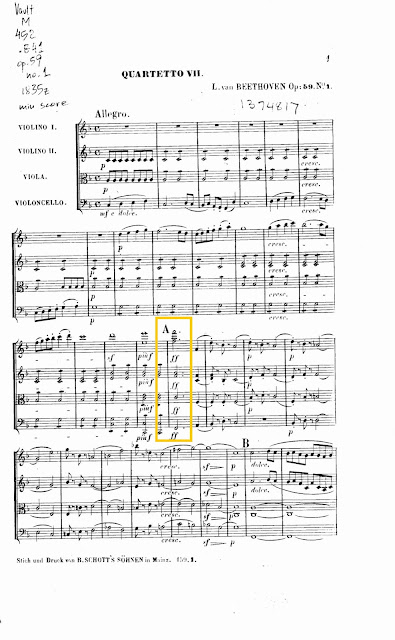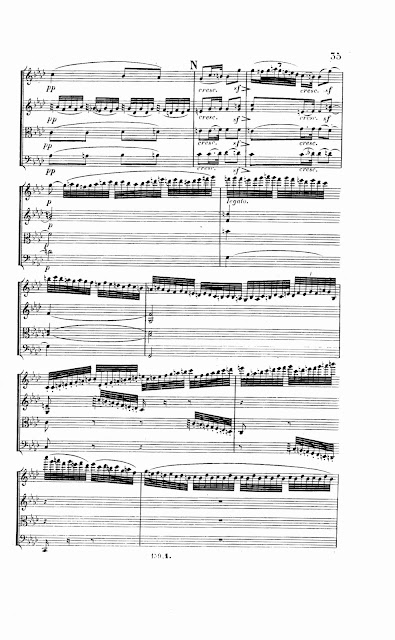CCCXLVI. BEETHOVEN, Ludwig van (1770-1827)
This nicely marks the beginning of the Middle Period.
The form is expanded; the playing time roughly doubled from the earlier Opus 18 set.
First Movement
The cello starts things off -- but check out the way Beethoven holds back the first tonic cadence until Bar 19!
Later, after cadencing on the subdominant (B-Flat), he inserts a little fugato:
The movement continues to unfold and bold and surprising ways -- a motif repeated and slightly changed here -- a riff exploding into diminished arpeggios, etc.
Second Movement
Seemingly contradictory Italian, allegretto vivace e sempre scherzando. [a little fast/very fast and always jokey!]
In the subdominant key (B-Flat Major), things begin simply enough, but in no time, Beethoven lands in the relative minor of the main F Major key -- D Minor.
In the subdominant key (B-Flat Major), things begin simply enough, but in no time, Beethoven lands in the relative minor of the main F Major key -- D Minor.
and just as quickly he moves to F Minor:
Moving through even more distant keys, delicacy and ferocity wildly compete.
The quartet plays the first pizzicato softly on the dominant, and then Beethoven brings the movement home with a firm tonic cadence:
Third Movement
One of Beethoven's most passionate, anguished slow movements, the key shifts to the parallel minor -- F Minor.
There is a stillness in the opening that's stunningly beautiful. The Danish are so exacting with Beethoven's careful dynamics indications -- the sfz's are perfect, etc.
When the 32nd-notes come into play (bottom of the page), and the cello plays those simple arpeggios against the violin -- magic!
When the 32nd-notes come into play (bottom of the page), and the cello plays those simple arpeggios against the violin -- magic!
Look how he introduces the pizzicato -- first in the cello, then viola, and violins:
We travel through distant keys (D-Flat Major; C Minor and finally C Major)
Beethoven still has another trick up his sleeve -- this passionate run of 64th-notes, first legato, then staccato -- leading to the attacca into the ...
... Fourth Movement
where he turns in his assignment for Razumovsky -- a Russian theme [see notes in Post CCXI] ...
After taking us on a helluva ride (with the tedious "theme" more or less eradicated), Beethoven slows things down and presents the thing in Adagio, before finishing the adventure with a rip-roaring Presto.

















No comments:
Post a Comment